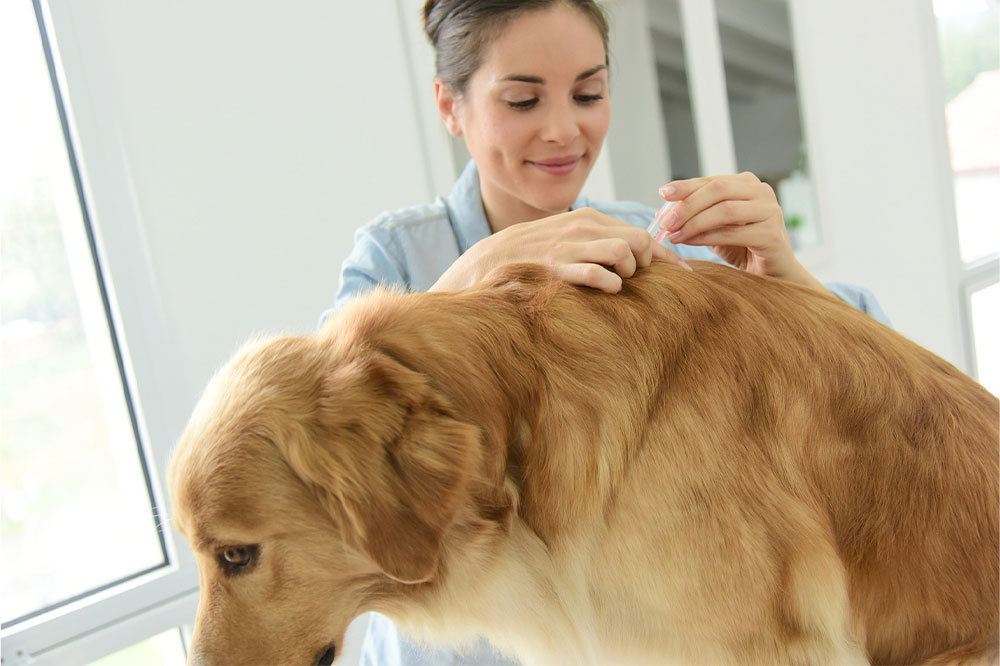
4 tips to get rid of fleas and ticks on dogs
Fleas and ticks are tiny, parasitic insects that live on the fur of their host animals like cats and dogs. These pests feed on the host’s blood as soon as they find a home on the animal’s skin. A tick or flea infestation can cause skin problems like itching, irritation, hair loss, and pale lips and gums. Here are a few treatment options, natural repellents, and tips for tackling an infestation:
Treatment options
Bravecto: This prescription treatment is available in oral and topical forms. It starts eliminating ticks within 12 hours and fleas within 2 hours. The oral treatment comes in the form of chewable meat-flavored tablets that can be easily eaten by dogs. Both the chews and the topical variant of Bravecto provide 12-week protection from fleas and ticks.
Simparica: This is a monthly chew that claims to get rid of 100% ticks within 8 hours and fleas within 3 hours. Simparica can work against a variety of ticks and fleas, staying effective for a month to prevent reinfestation. One of its advantages is that the Simparica chewable can be taken without food. It is an oral prescription that helps kills the pests on the skin or fur of the dog.
Advantix: Advantix is a topical solution that kills fleas and ticks on contact. This treatment option works against various insects, including fleas, ticks, sandflies, lice, stable flies, and even mosquitoes, and so, the risk of heartworm infection (caused by a parasitic worm carried by mosquitos) in dogs is reduced. Advantix is also recommended for dogs with a history of uncontrolled seizures.
Food-based repellents
Apple cider vinegar: A homemade solution containing one part apple cider vinegar and one part water can be sprayed directly onto the fur while avoiding contact with the dog’s eyes. A tablespoon of ACV can also be added to your pet’s water bowl to keep the insects away. While it may not kill the pests, it can repel fleas and ticks as they despise the taste of ACV. You can also directly use the vinegar on a tick that has latched on to your pet. Just dip a small cotton ball into vinegar and place it over the affected area, taking it off once the pest releases its hold.
Garlic: This option should be used with caution as garlic contains thiosulphate, which can be toxic for dogs. However, it has tiny amounts of thiosulphate, so you would have to feed your dog a significant amount of garlic for it to have any adverse effect. Garlic can change the smell and taste of the animal’s skin, which repels fleas. The best way to ensure efficacy is to use fresh, organic cloves. Based on the vet’s recommendation, feed a quarter clove of garlic for every 10 pounds of body weight.
Tips for dealing with an infestation
Ensure cleanliness: To get rid of fleas, it is vital to keep your dog’s coat and its environment (i.e., your backyard and home) clean. Wash the dog’s bedding in hot water using a natural, unscented detergent twice a week. Brushing the dog’s coat regularly will also help eradicate fleas and ticks. In addition, keep an eye out for ticks in grass or low-hanging shrubs, and maintain a manicured yard to avoid attracting pests. Vacuuming can also remove eggs and larvae under the carpets.
Use nematodes: Nematodes are soil-dwelling worm-like creatures. These tiny organisms feed on tick larvae, breaking the parasite’s life cycle and killing it. Currently, beneficial nematodes (or Steinernema carpocapsae) are utilized to manage fleas and are viable alternatives to chemical pesticides as these nematodes are non-toxic to pets and humans and are easy to use. They can target both larval and pupal stages of fleas within 48 hours of administration, preventing the next generation of adults from developing. You can fill a sprayer or a can with water and add the nematodes to the container before scattering them throughout your yard.
Use flea collars: A homemade collar using essential oils can help your dog stay pest-free without spraying or rubbing the mixture on them. Buy or make a dog collar using a bandanna, dilute a few drops of lavender or cedar oil using water and rub it on the collar. Tie this around your pet’s neck, making sure that they can’t reach it. The scent of certain essential oils like lavender repels pests. This should be used with caution so that it is not consumed by the dog, and these oils should not be applied in their concentrated form.
Stay vigilant: You should take preventive measures and not wait until your dog starts scratching to check for these insects. Run a flea comb over the dog’s coat on a regular basis, and if already affected, use a spray or bathe your pet using a flea and tick shampoo designed to kill these pests. If your dog spends time outdoors in the woods or other such areas, check for visible ticks and manually remove any that you discover.
Easily available treatment options like Bravecto, Simparica, and Advantix can provide quick relief and prevent reinfestation. It is important to tackle these parasites with urgency, as fleas and ticks can not only be irritating for dogs and pet owners but can also carry illnesses like Lyme disease.


